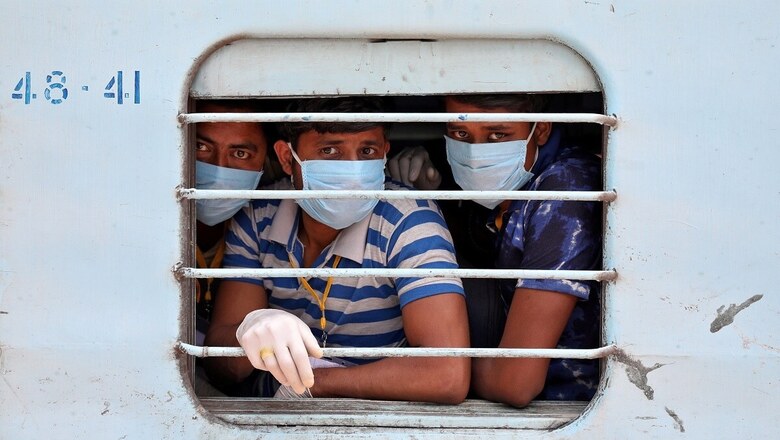Gulf Returnees, Reverse Migration, Dying Job Market: ‘Underdog’ Factors That May Decide Bihar Battle

views
Rising unemployment is a slowly unfolding crisis in Bihar. The state is expected to have assembly elections in October-November, even as it has been battered by floods and rising novel coronavirus cases. However, the youth unemployment and reverse migration from other parts of India and the Gulf have turned into an underlying crisis that has largely been ignored by the state government.
As the Centre imposed a lockdown throughout the country, the migrants who once were part of the daily economy in mega cities, headed for home as economic activities came to a standstill.
Bihar was the state that received the largest number of ‘reverse migrants’. According to government data, around 15,00,000 people have returned to the state in Shramik trains from across the country in the lockdown months. Another 2 lakh people came by buses.
However, reports indicate that the number of migrants returning could be much higher. As of May, more than 29 lakh migrants had registered for the ₹ 1,000 aid promised by the state government after the lockdown.
Why Bihar Has One Of The Highest Unemployment Numbers
According to the Census 2011, 7.5 million migrants reported Bihar as their origin state. The maximum number of migrants cited ‘search for work/employment’ as their reason for migration, followed by ‘moved with household.’
“While there has been a relative decline in unemployment over the decades throughout India, the unemployment figures have risen in Bihar,” says Avinash Kumar, who teaches at Jawaharlal Nehru University in Delhi. “Data will say that industry is growing. But somehow employment is not generating.”
According to Kumar’s study, the increasing number of factories hardly made any significant contribution to employment generation. In the period between 2011−12 and 2016−17, the number of workers per factory declined from 34 to 28.
In 2017−18, as the country was witnessing a massive rise in unemployment, Bihar underwent the same. However, the unemployment rate in Bihar (7.2%) was higher than the average for the country (6.1%), according to the Periodic Labour Force Survey, 2019.
CMIE’s monthly data for August shows unemployment at 13.1%, almost double the national average.
Flood Economy And Casual Labour
This year almost 16 out of 38 districts in Bihar have been hit by floods, affecting over 63 lakh people. The flood-affected areas are the ones witnessing the maximum unemployment. According to the union skill development ministry, the maximum migrants have returned to East Champaran, Katihar, Madhubani, Gaya, West Champaran, Darbhanga, Araria and Muzaffarpur.
In 2017-18, the share of casual labour in Bihar was 32.1%, higher than the national average (24.3%). The flood-affected areas leave a narrow scope for development and of setting up of industries. Also, the Seemanchal area of Bihar with four districts- Purnea, Katihar, Kishanganj and Araria- also lags in development and literacy.
Reverse Migration
As 2 million people came back from different states, another sizeable number has returned from abroad. According to the emigration data from the ministry of external affairs, 9 out of the 50 districts in India receiving the highest immigration were in Bihar. The nine districts, including Darbhanga, East Champaran, Gopalganj and Madhubani, received the highest returnees from Saudi Arabia, UAE, Qatar, Oman and Kuwait. However, the total number of migrant labour is not known.
“Reverse migration from the Gulf started as early as 2012-13. When we studied returning migrants, we found that only 11% were able to find jobs based on their experience; the remaining 89% was in casual employment or unemployed,” Avinash Kumar says.
Experts say that the exodus from the Gulf could hurt the remittances from overseas workers, especially in West Asia. Districts including Gopalganj and Siwan receive the highest remittances from the Gulf.
Opposition Gears Up
As the state gets ready for polls, the rising unemployment especially among youths is a major concern. A report in The Wire indicated that youth unemployment is as high as 40 per cent.
Due to the neglect of the flood-ravaged parts and migration, the Seemanchal area has witnessed the rise of alternate parties trying to gain a foothold. Pappu Yadav’s Jan Adhikar Party is trying to make its presence felt in the flood-hit areas and is campaigning in Seemanchal. Asaduddin Owaisi’s AIMIM won the Kishanganj seat in the 2019 bypolls and the party is eyeing constituencies with Muslim predominance, including Kishanganj, Purnia, Araria and Katihar.
The major opposition party, the RJD, has already launched a digital portal for employment, to garner support. The party has claimed that over 5 lakh people have already registered and another 10 lakh have dialled their toll-free number in the last 11 days since the launch.



















Comments
0 comment